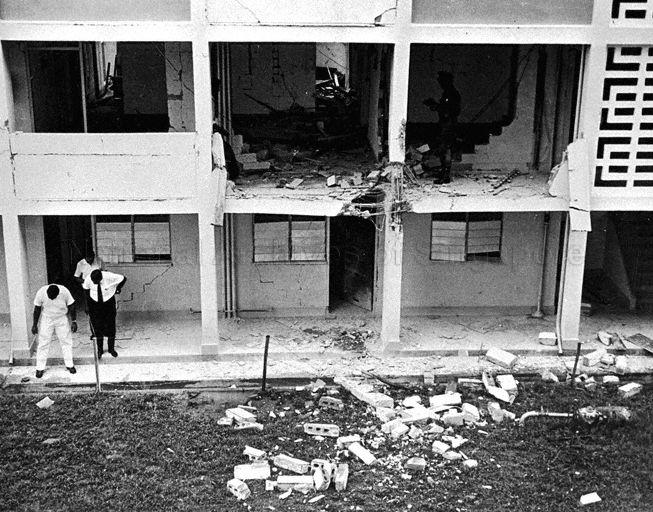The Singapore Armed Forces recently concluded Exercise Suman Warrior, a Five Power Defence Arrangement (FPDA) land exercise in June 2018.
The "five powers" involved in the FPDA defence exercises are Australia, Malaysia, New Zealand, Singapore, and the United Kingdom.
Set up when Britain was pulling military out
In July 1967, Britain announced that they were pulling out all of their military forces "East of the Suez".
Her lagging economy back home meant that she could not afford the £70 million-a-year maintenance of British military bases here.
 Via NewspaperSG.
Via NewspaperSG.
Aside from the economic impact on jobs here, it was thought that the defence vacuum would leave Singapore and Malaysia vulnerable to hostile forces in the region.
As a result, Singapore sought to put in place a deterrent measure, which was to be the Five Power Defence Arrangement (FPDA).
Guarding against an Indonesian threat
Tim Huxley, the Executive Director of The International Institute for Strategic Studies - Asia wrote in 2017 that one of the motivating factors for the FPDA was the possibility of an Indonesian threat.
 MacDonald House bombing in March 1965 during Konfrontasi. Via NAS.
MacDonald House bombing in March 1965 during Konfrontasi. Via NAS.
Konfrontasi was the Indonesian-led guerrilla campaign (1963 to 1966) in response to the formation of Malaysia.
It resulted in a wave of violence across the island, most notably the attack on MacDonald House, which killed two people and injured 33.
Indonesian military conducted cross-border raids in Sabah and Sarawak. Amphibious raids were launched by Indonesian commandos on Johor and Singapore's coastal areas. Although they were mostly foiled, there was much damage left in their wake.
 A bombed HDB flat during Konfrontasi. Via NAS.
A bombed HDB flat during Konfrontasi. Via NAS.
Despite signing a peace agreement between Malaysia and Indonesia to end Konfrontasi, it was clear that Singapore and Malaysia needed to ensure that a deterrent measure was ready at a moment's notice to prevent such a thing from happening again.
Hence, the FPDA was conceived to be a transitional agreement between Malaysia and Singapore and the other three countries until both of the former can fend for themselves.
[related_story]
Immediate consultation during a threat
Under the FPDA, members are obliged to consult each other during an imminent threat on any of the five members.
An Integrated Air Defence System (IADS) was set up at Butterworth, Penang in September 1971 to protect both Malaysian and Singapore airspace. This later became the Integrated Area Defence System.
The agreement allows land-scarce Singapore to conduct training exercises (such as Ex Suman Warrior and Ex Bersama Lima) in different terrains and land otherwise unavailable to us.
Joint exercises enable our armed forces to learn from other militaries and enhance interoperability.
However, one of the main benefits of the FPDA is the psychological deterrence it affords, especially important at a time when Singapore and Malaysia were reeling from the shock of Konfrontasi and Vietnam was in the throes of the Vietnam War.
Is the FPDA still relevant?
Fast forward 47 years and the FPDA is still around, making it the world's second oldest military partnership in existence.
As recent as June 2018, defence ministers from all five member countries "reaffirmed" their commitment to the FDPA as a "constructive, transparent, and peaceful arrangement" in the region.
However, the conditions that kickstarted the FPDA -- namely a hostile Indonesia and the potential spread of Communism in Indochina -- have largely disappeared.
Except for the occasional sniping, countries in the region have been maintaining a peaceful co-existence and strengthened their relationships via ASEAN -- incidentally, another organisation that was originally set up to rebuild regional ties with Indonesia.
The question now is: Is the FPDA still relevant today?
The Asia Pacific is, in the words of ex-British defence secretary, Michael Fallon, "the fastest growing region of the world" today and "vital for the prosperity of the world trading system", making it imperative for all members of the FPDA to have a foothold in the region for economic or political interest.
Since 2006, the FPDA has expanded its scope to include terrorism and disaster relief operations.
For example, New Zealand received humanitarian help from FPDA member states Singapore and Australia during the 2011 Christchurch earthquake.
However, in today's context, security threats have evolved beyond simple cross-border raids.
They now encompass a myriad of threats from international terror attacks to cyber warfare.
In keeping with the original purpose of the FPDA, member states have agreed to share intelligence regarding terrorist threats against both Malaysia and Singapore.
The FPDA will be celebrating its 50th anniversary in 2021.
In the face of Islamic State incursions in Southeast Asia and tensions in the South China Sea, here's hoping the FPDA continues to be relevant in an increasing turbulent region.
Top image via CyberPioneer
If you like what you read, follow us on Facebook, Instagram, Twitter and Telegram to get the latest updates.
